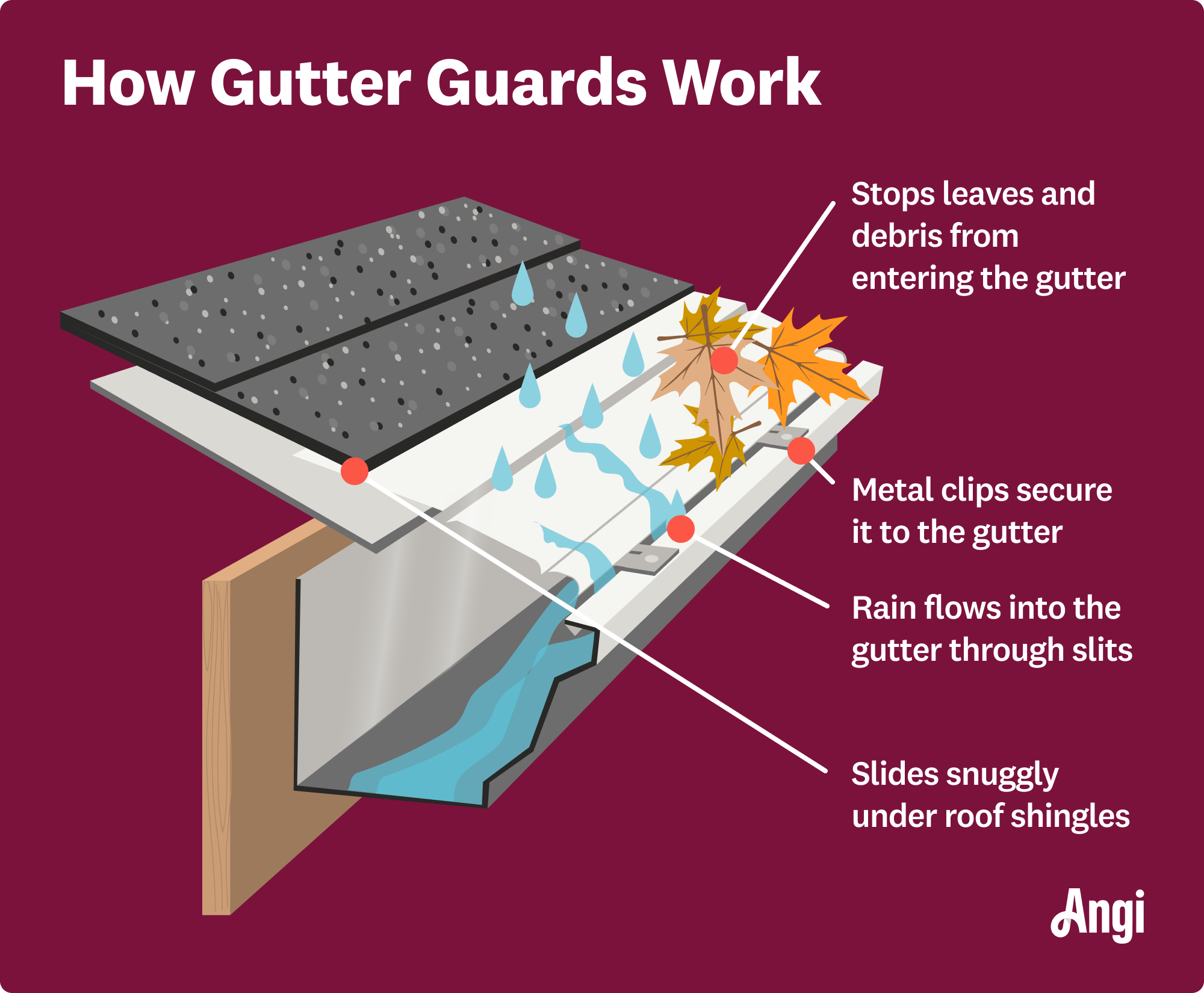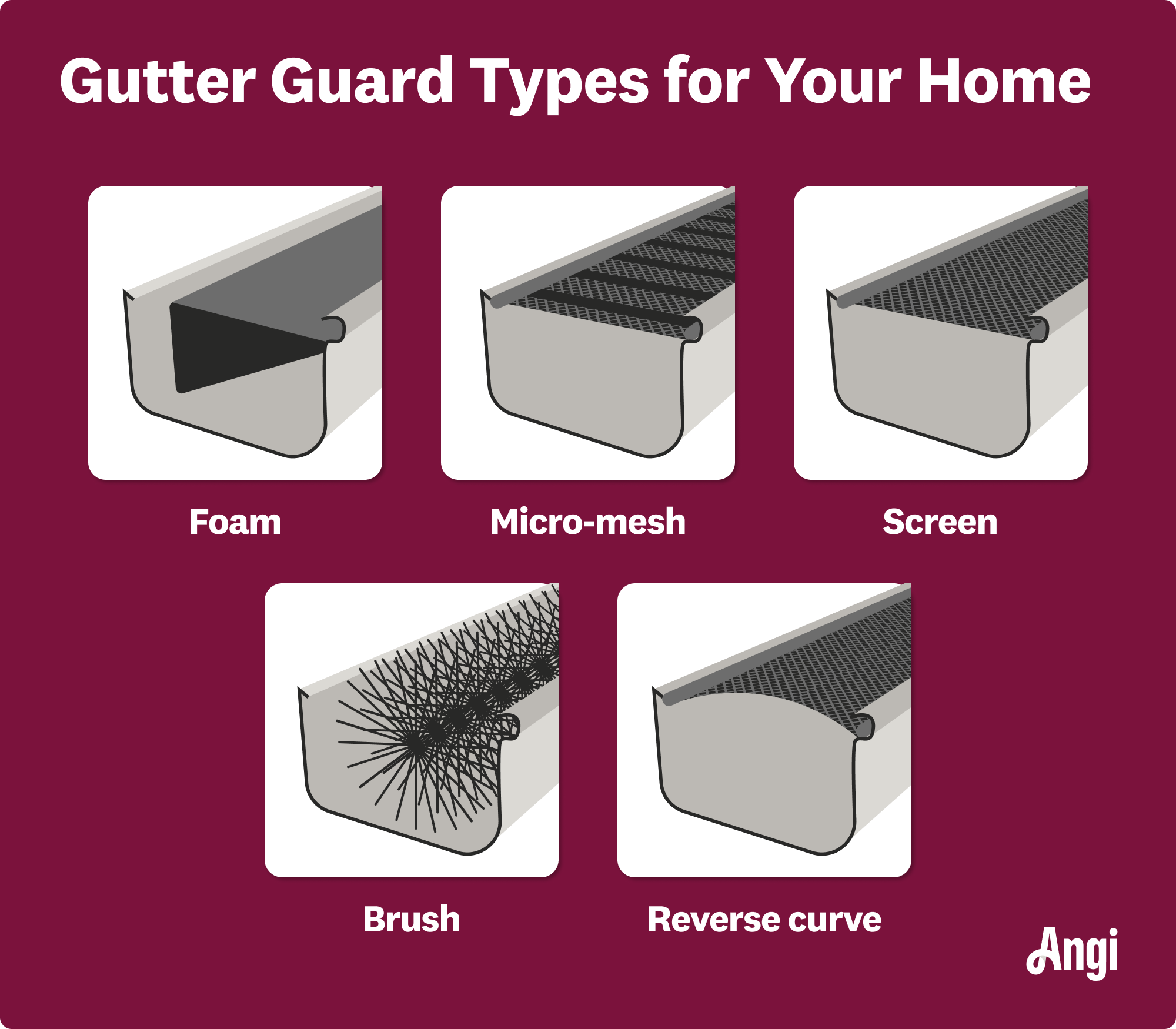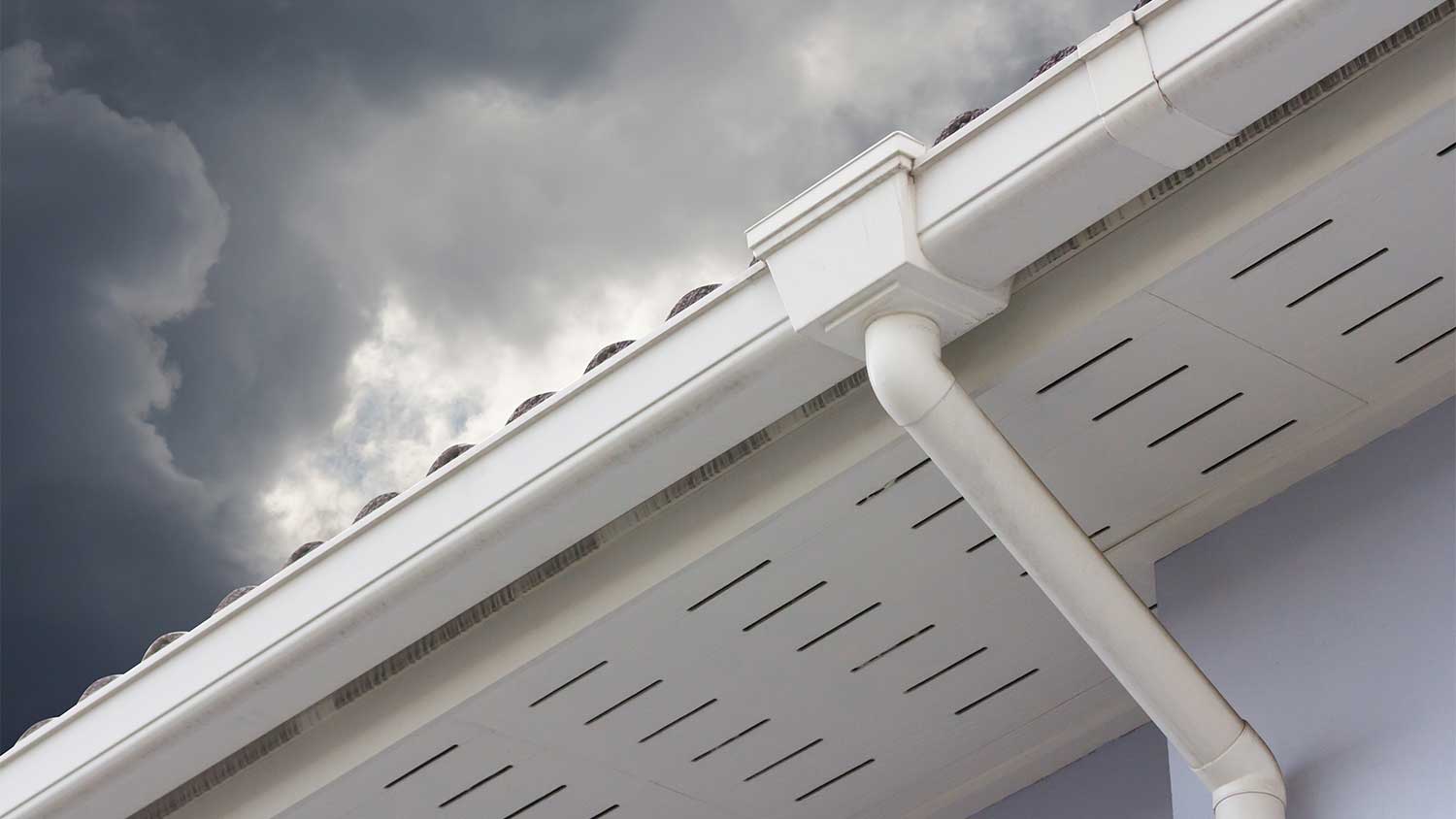Are Gutter Guards Worth It, and Do They Add Value to Your Home?
Your gutter guardians work 24/7 so you don’t have to


Home Value Rating: 1/5
Gutter guards don’t add much resale value, but a pro can help ensure it looks its best.
The average return on investment (ROI) for gutter guards is between 0% and 10%.
The main value of installation is preventing future damage—not securing a reasonable return.
You may find the benefits of gutter guards make up for their low ROI.
Gutters are an integral part of your home, channeling powerful amounts of water away from your roof and, ideally, your foundation. Gutter guards—perforated metal strips laid over the gutter—can block all but the smallest debris and allow the gutters to work as intended. Many homeowners love the convenience gutter guards offer as they no longer need to clean gutters two, three, or more times per year.
However, with an average installation cost of $1,515 and an average return on investment (ROI) of 0% to 10%, gutter guard installation isn’t all sunshine and roses. You won’t recoup most of the investment, but gutter guards prevent costly damage to the roof or gutters.

Factors That Influence Gutter Guard Value

All gutter guards work by filtering or shielding debris from entering your gutters and causing a blockage. How each one works depends on the type of gutter guard you choose, where you place it, and the size of the guard installed.
Gutter Guard Size
The average home uses around 150 to 250 linear feet of gutters, so you’d need the same length of gutter guards installed. The values below show a wide range as the type of gutter guard you use has a significant impact on cost per linear foot. Also, remember shorter lengths will cost more per linear foot, so there is an economy of scale for larger projects.
| Linear Feet | Average Cost |
|---|---|
| 40 | $400–$800 |
| 75 | $600–$900 |
| 100 | $650–$1,200 |
| 130 | $900–$1,400 |
| 150 | $1,000–$1,700 |
| 180 | $1,200–$2,000 |
| 200 | $1,350–$2,150 |
| 250 | $1,600–$2,800 |
| 300 | $2,000–$3,400 |
Gutter Guard Type
There are five types of gutter guards that you can choose for gutters. Here’s a look at each type to help you decide on the best gutter guards for your home.

Screen Gutter Guards
Screen guards come in plastic or metal grids. You install the screens by carefully pushing them under the roof shingles to hold them in place. Keep in mind that this option can void roof warranties if improperly installed, and high wind can pull them out of place. Most screen guards last between five to 10 years, with plastic screen guards falling toward the lower end and metal screen guards coming in as the longest-lasting option.
Micro-Mesh Gutter Guards
Micro-mesh guards can also slide into shingles, but they come in other options that make them sturdier than screen guards. These guards can get clogged more easily and tend to be one of the more expensive options. However, most micro-mesh gutter guards have a lifespan of 20 years or longer. For the longest lifespan, go for a metal micro-mesh gutter guard system.
Reverse-Curve Gutter Guards
Ideal for yards with many leafy trees, reverse-curve guards slide under or hook atop the shingles, cover your entire gutter, and have a curve that allows for leaves to slide off. Reverse-curve gutter guards can last between 10 and 25 years on average. How long a reverse-curve gutter guard lasts depends on how well it’s installed. This type of gutter guard can be more difficult to install correctly, and an improperly installed gutter guard can quickly shorten its lifespan.
Brush Gutter Guards
Brush guards are large metal brushes with thermoplastic bristles. Their shape prevents leaves from clogging your drains while allowing water to slip past. Brush guards are easy to install and flexible; you just place them into your gutters. In terms of longevity, brush gutter guards fall a little short compared to metal gutter guards, at around a five- to 10-year range.
Foam Gutter Guards
A foam guard is a gutter guard that comes in the shape of a triangle. The corner and edge of one side lie against the bottom of your gutter, while the flat upper part goes across the top, preventing debris from entering. Climates with lots of rainfall may not be suitable for foam guards, as they can’t handle intense rain without overflowing or deteriorating. Foam guards have several pros and cons. The main downside is that they last only one to two years on average, depending on the foam quality.
DIY Gutter Guard Installation vs. Hiring a Pro
DIYing gutter guards will save you money during installation, but not much once you consider the cost of buying tools if you don’t already own them. In addition to the gutter guard materials, these include a ladder and safety gear, like glasses and gloves.
While you can install gutter guards yourself, the installation process has significant safety hazards. It’s a time-consuming project that can quickly become a major pain if you’re not used to working at heights and on ladders. Not to mention, improperly installing gutter guards can void your roof’s warranty or lead to costly roof repairs.
If you don’t have experience installing gutter guards or working with rooftops and ladders (or even if you do), it’s a good idea to contact a gutter guard installer near you to safely do the job and provide the proper warranties.
How to Estimate the Added Value of Gutter Guards
Gutter guards are not like a kitchen remodel—homeowners shouldn’t have investment considerations in the front of their minds when considering gutter guards. The reason is that you won’t be likely to recoup more than 10% of the cost of the project, and you won’t see a dollar value increase in your home’s value.
The real value of gutter guards is protecting your gutters but more importantly, your roof. Installed gutter guards have “soft value” when buyers are looking, especially if your area sees high levels of rain and debris.
Cost to Install Gutter Guards
Gutter guards cost anywhere between $1 and $10 per linear foot, not including installation, which costs an extra $9 per linear foot on average. Gutter guard installation costs $1,515 on average, but prices can fall anywhere between $600 and $2,400. Cost factors that can affect the total cost of your project include:
Materials used
Gutter length
Type of gutter guard
Local labor costs
Is Installing Gutter Guards Worth It?
We would say “yes” but with the caveat that not every home needs gutter guards, and not every gutter guard on the market is worth it. Your budget, climate, installation method, willingness to maintain and clean the gutter guards, the number of trees, and the type of gutter guard can all contribute to whether or not gutter guards are worth it.
It’s important to understand your home’s needs and the amount of maintenance that goes into keeping your gutter system smooth-flowing, and how preventative you want to be with things like ice damming when making a decision. If you’re unsure if gutter guards are worth it, a local gutter company will look at your home on a case-by-case basis and recommend the best gutter guard for your budget, lifestyle, landscape, and climate.
How Angi Gets Its ROI Data
Home is the most important place on earth, which is why Angi has helped more than 150 million homeowners transform their houses into homes they adore. To help homeowners maximize the value of their investments, we gather ROI data from reputable sources, including industry reports, real estate studies, and interviews with market experts. We calculate the average resale value for projects by multiplying the ROI against the project’s average cost according to our cost data, which is sourced from thousands of real Angi customers.
Want to help us improve our data? Send us a recent project quote or home appraisal value to costquotes@angi.com. Quotes and personal information will not be shared publicly.
Frequently Asked Questions
Gutter guards work in heavy rain, but perhaps not as well. The main purpose of gutter guards is to protect your gutters from getting clogged with debris, which can be carried (or worsened) by heavy rain. However, a clogged gutter isn’t the only reason rain isn’t traveling through your gutter properly. Other reasons include roof shingles extending past your gutters, improperly installed gutters, or incorrect gutter sizes.
If you suspect you have any of these other gutter issues, it may be more cost-effective to repair your gutters first and see if that solves the problem before investing in gutter guards.
Yes. Gutter guards aren’t 100% foolproof. While gutter guards can keep debris out, some small pieces like leaves, pebbles, and pests can still accumulate over time. The main benefit of gutter guards is their ability to dramatically reduce the amount of annual cleaning you have to do, sometimes requiring only once a year or even less.
Whether or not you can use a pressure washer to clean your gutter guards depends on the type of gutter guard you have and the strength of the pressure washer. Most gutter guards can handle a low-pressure setting but check first. If you’re unsure if your gutter guard is designed for pressure washing, check your manufacturer’s instructions, ask a pro, or use a garden hose to clean the gutter guard instead. As gutter guards age, they become less resistant to the strong forces of a power washer, so treat older gutter guards with more care.
While gutter guards offer significant advantages, they also have some drawbacks—namely, they don't completely eliminate the need for cleaning, and certain objects (like mold or large debris) can still damage your roof. If they're installed improperly, they can void the roof warranty, and heavy guards could even damage your roof fascia or roof material itself. This is why it's vitally important to have a pro install your gutter guards.





- The Pros and Cons of Micro Mesh Gutter Guards
- Gutter Cleaning 101: What Does It Include and Why Is It Important?
- Who Do You Hire to Clean Your Gutters?
- How Long Do Gutters Last? Learn When Should Your Gutters Be Replaced
- 10 Signs Your Gutters Were Installed Incorrectly
- How to Clean Gutters Without a Ladder
- Importance of Gutter Slope to Your Home
- 6 Must-Have Downspout Cleaning Tools to Keep the Water Flowing
- 5 Types of Gutter Hangers for Your Home
- 5 Types of Snow Guards for Metal Roofs










